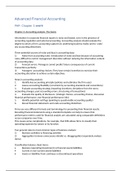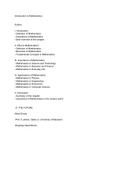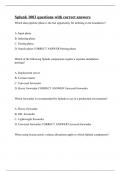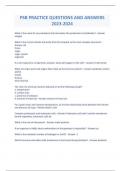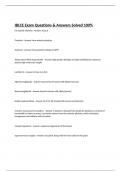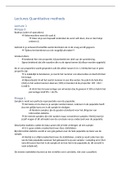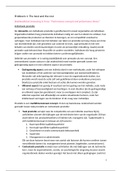Advanced Financial Accounting
PHP: Chapter 3 and 5
Chapter 3: Accounting analysis: The basics
Information in corporate financial reports is noisy and biased, even in the presence of
accounting regulation and external accounting. Accounting analysis should evaluate the
degree to which a firm’s accounting captures its underlying business reality and to ‘undo’
any accounting distortions.
Three potential sources of noise and bias in accounting data:
1) Noise from accounting rules: Introduction of noise and bias because of accounting
rules, difficult to restrict management discretion without reducing the information content
of accounting data.
2) Forecast errors: Managers cannot predict future consequences of current
transactions perfectly.
3) Managers’ accounting choices: They have certain incentives to exercise their
accounting discretion to achieve certain objectives.
Steps in accounting analysis:
1. Identify key accounting principle (policies and estimates the firm uses)
2. Assess accounting flexibility (constraint by accounting standards and conventions)
3. Evaluate accounting strategy (reporting incentives, deviations from the norm,
accounting changes, past accounting errors, structuring of transactions)
4. Evaluate the quality of disclosure (strategic choices, accounting choices, discussion
financial performance, non-financial performance info)
5. Identify potential red flags (pointing to questionable accounting quality)
6. Recast financial statements and undo accounting distortions
Firms use very different formats and terminology for presenting their financial results.
Recasting financial statements using a standard template can help to ensure that
performance metrics used for financial analysis are calculated using comparable definitions
across companies over time.
This causes some complications, for example, that IFRS allows firms to classify their
operating expenses by nature or by function.
Two general rules to most common types of business analysis:
1) Business activities vs financing activities
2) Aggregation (remove unnecessary details) vs. disaggregation (separately analyze
items)
Classification balance sheet items:
• Business (operating/investment) vs financial assets/liabilities
• Current vs non-current assets/liabilities
• Assets or liabilities from continues vs discontinued operations
,A & W: Chapter 8, 9 and 17
Chapter 8: A framework for interpretation
Financial analysis concerns with two areas of inquiry:
1) Evaluation of the financial structure and policy of a company
Financial risk Financial structure and financial position Composition of sources
– equity vs. debt. Risk is part of investing, but investors want a higher return when
there is a higher risk (risk/return relationship).
2) Evaluation of corporate management’s performance
How efficient and effective is management using the company’s funds and assets? –
Return side investors’ decision and predicts future returns.
Return the investor wants should…
a. Compensate for inflation
b. Equal the return available from no-risk investments
c. Provide compensation for the risk
Financial structure
Gearing = the proportion of debt to equity. Within the debt, the term structure of maturity
mix is important (when does the debt fall due to repayment – advantage is tax shield).
No guide for a good debt/equity mix – industry patterns (high-tech have high risk and
therefore little financial gearing)
Size/ownership can explain debt structure
- Family-held/director-controlled – avoid equity because of loss management control
- Small and medium-sized companies – higher gearing than competitors
Financial structure:
Assets Financing
Productive capacity Long-term financing from owners
(long-term assets)
Long-term financing from lenders
Working capital
(inventory, trade receivables, cash) Working capital
(trade payables)
Gearing:
Assets Financing
Non-current assets Equity
(long-term assets) (long-term financing from owners)
Current assets Debt
, (inventory, trade receivables, cash) (long-term financing from lenders)
Current liabilities
(trade payables)
Sources of finance
- Share issue
Rights issue = Company asks existing shareholders to subscribe more
Underwritten share issue = Institutions would guarantee to company to buy all unsold
shares at predetermined price (large fee for accepting this risk, not frequent)
Prospectus = Detailed statement about past performance/future expectations, accompanied
by share issue
Alternative: Issue shares on different capital market (new sources, no discount, finance
foreign currency)
- Loans
Financial institutions or directly through public markets
Syndicated loans = Finance provided by a group of banks, commonly for government but
also special transactions commercial companies.
Rate of interest is usually a floating rate (market interest rate indicator)
- Bonds
Issuing debt directly to capital market (bonds), frequently at fixed interest rate.
- Leasing
Company rents an asset with finance often supplied by supplier of asset
Other aspects of debt management:
Maturity mix – scheduling of repayment debt (same time?)
Currency
Interest rates – floating or fixed
Hedging
Risks when investing in foreign currency
- Commercial risk (yield a suitable return?)
- Currency risk (more costly over time)
Dividend policy
Shareholders gain from equity investment in two ways:
- Dividend
- Market appreciation (increase stock market price of shares)
Which one of the two is preferred, depends on the investor. The clientele effect means that
companies acquire the clientele that prefers their approach to this question.
Dividend policy is important because of its potential effect on shareholder wealth and the
effect on company’s cash flow and financing.
PHP: Chapter 3 and 5
Chapter 3: Accounting analysis: The basics
Information in corporate financial reports is noisy and biased, even in the presence of
accounting regulation and external accounting. Accounting analysis should evaluate the
degree to which a firm’s accounting captures its underlying business reality and to ‘undo’
any accounting distortions.
Three potential sources of noise and bias in accounting data:
1) Noise from accounting rules: Introduction of noise and bias because of accounting
rules, difficult to restrict management discretion without reducing the information content
of accounting data.
2) Forecast errors: Managers cannot predict future consequences of current
transactions perfectly.
3) Managers’ accounting choices: They have certain incentives to exercise their
accounting discretion to achieve certain objectives.
Steps in accounting analysis:
1. Identify key accounting principle (policies and estimates the firm uses)
2. Assess accounting flexibility (constraint by accounting standards and conventions)
3. Evaluate accounting strategy (reporting incentives, deviations from the norm,
accounting changes, past accounting errors, structuring of transactions)
4. Evaluate the quality of disclosure (strategic choices, accounting choices, discussion
financial performance, non-financial performance info)
5. Identify potential red flags (pointing to questionable accounting quality)
6. Recast financial statements and undo accounting distortions
Firms use very different formats and terminology for presenting their financial results.
Recasting financial statements using a standard template can help to ensure that
performance metrics used for financial analysis are calculated using comparable definitions
across companies over time.
This causes some complications, for example, that IFRS allows firms to classify their
operating expenses by nature or by function.
Two general rules to most common types of business analysis:
1) Business activities vs financing activities
2) Aggregation (remove unnecessary details) vs. disaggregation (separately analyze
items)
Classification balance sheet items:
• Business (operating/investment) vs financial assets/liabilities
• Current vs non-current assets/liabilities
• Assets or liabilities from continues vs discontinued operations
,A & W: Chapter 8, 9 and 17
Chapter 8: A framework for interpretation
Financial analysis concerns with two areas of inquiry:
1) Evaluation of the financial structure and policy of a company
Financial risk Financial structure and financial position Composition of sources
– equity vs. debt. Risk is part of investing, but investors want a higher return when
there is a higher risk (risk/return relationship).
2) Evaluation of corporate management’s performance
How efficient and effective is management using the company’s funds and assets? –
Return side investors’ decision and predicts future returns.
Return the investor wants should…
a. Compensate for inflation
b. Equal the return available from no-risk investments
c. Provide compensation for the risk
Financial structure
Gearing = the proportion of debt to equity. Within the debt, the term structure of maturity
mix is important (when does the debt fall due to repayment – advantage is tax shield).
No guide for a good debt/equity mix – industry patterns (high-tech have high risk and
therefore little financial gearing)
Size/ownership can explain debt structure
- Family-held/director-controlled – avoid equity because of loss management control
- Small and medium-sized companies – higher gearing than competitors
Financial structure:
Assets Financing
Productive capacity Long-term financing from owners
(long-term assets)
Long-term financing from lenders
Working capital
(inventory, trade receivables, cash) Working capital
(trade payables)
Gearing:
Assets Financing
Non-current assets Equity
(long-term assets) (long-term financing from owners)
Current assets Debt
, (inventory, trade receivables, cash) (long-term financing from lenders)
Current liabilities
(trade payables)
Sources of finance
- Share issue
Rights issue = Company asks existing shareholders to subscribe more
Underwritten share issue = Institutions would guarantee to company to buy all unsold
shares at predetermined price (large fee for accepting this risk, not frequent)
Prospectus = Detailed statement about past performance/future expectations, accompanied
by share issue
Alternative: Issue shares on different capital market (new sources, no discount, finance
foreign currency)
- Loans
Financial institutions or directly through public markets
Syndicated loans = Finance provided by a group of banks, commonly for government but
also special transactions commercial companies.
Rate of interest is usually a floating rate (market interest rate indicator)
- Bonds
Issuing debt directly to capital market (bonds), frequently at fixed interest rate.
- Leasing
Company rents an asset with finance often supplied by supplier of asset
Other aspects of debt management:
Maturity mix – scheduling of repayment debt (same time?)
Currency
Interest rates – floating or fixed
Hedging
Risks when investing in foreign currency
- Commercial risk (yield a suitable return?)
- Currency risk (more costly over time)
Dividend policy
Shareholders gain from equity investment in two ways:
- Dividend
- Market appreciation (increase stock market price of shares)
Which one of the two is preferred, depends on the investor. The clientele effect means that
companies acquire the clientele that prefers their approach to this question.
Dividend policy is important because of its potential effect on shareholder wealth and the
effect on company’s cash flow and financing.



